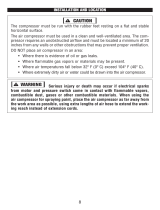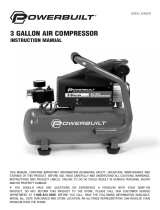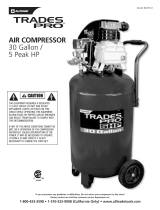4
• Do not overreach. Proper footing and balance is a must at all times while using tools.
Unstable support may lead to personal injury. Do not stand on the tool. Serious injury
could result if the tool tips over or you accidentally contact the tool.
• Never leave the air compressor running unattended. Always turn the power to the OFF
position and do not leave the air compressor until it comes to a complete stop.
• When using air accessories, consult the owner’s manual provided by the manufacturer.
The use of improper accessories may cause risk of injury to yourself and others.
• Always make sure the tool is in the OFF position and unplugged from the electrical
receptacle when making adjustments, changing parts, or performing any maintenance.
• Secure work. When possible, the use of clamps or a holding device is much safer than
holding the work piece with your hands.
• Keep protective guards in place and in proper working condition.
• Maintain tools and equipment with care. they will function better and more safely when
kept clean and in good working condition. Keeping the air compressor clean, dry, and free
of grime will add to its life and performance.
• Childproof the workshop. The use of master switches and padlocks is highly
recommended. Remove starter keys where applicable.
Drain liquid from air tank daily
• Use the drain valve located on the bottom of the lower air tank to drain. Failure to
properly drain liquid from the tank will cause rust from moisture buildup, which weakens
the tank and could lead to a violent tank explosion. Periodically inspect the tanks for
unsafe conditions such as corrosion, cracked welds, and leaks.
• Release air slowly when draining moisture or depressurizing the air compressor. Fast
moving air will stir up dust, dirt, and debris, and may be harmful.
Risk of fire or explosion
• Avoid dangerous environments. Do not spray combustible/flammable liquid in a confined
area. Spray area must be well ventilated. Do not smoke while spraying or spray where
spark or flame is present. Arcing parts - keep compressor at least 20 ft. away from
spraying area and all explosive vapors. Do not use compressor near gasoline or other
flammable materials.
Important Operating Instructions
GENERAL SAFETY INSTRUCTIONS





















